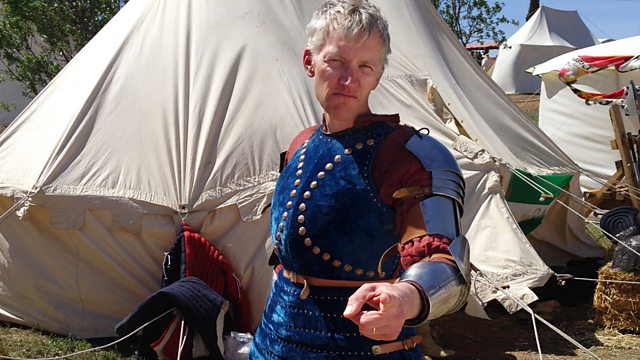10/02/2015
Tom Holland finds out how different regimes have used Dresden's wartime history. Back home, Martin Ellis asks if heritage is key to the economic rejuvenation of the Potteries.
Seventy years on from dramatic and deadly Allied air attacks, Tom Holland visits Dresden in the east of Germany. He finds out how the city has dealt with this history, why it continues to concern us and how different regimes have used it.
In the studio, Helen Castor and her guests - Professor Richard Overy (University of Exeter) and Dr Astrid Swenson Lecturer in Politics and History at Brunel University - discuss the horror of those nights in February 1945 and how they compared with bombing raids on other European cities such as London, Coventry and Hamburg.
Back in England, Martin Ellis visits Stoke-On-Trent to find out whether history and heritage can replace garden festivals to become a major factor in the social and economic rejuvenation of the Potteries.
Contact the programme by email: making.history@bbc.co.uk - or write to Making History, ±«Óătv Radio 4, PO Box 3096. Brighton BN1 1PL.
Producer: Nick Patrick
A Pier production for ±«Óătv Radio4.
Last on
Making History
Helen Castor presents as listeners and historians come together to share the latest historical research.
Today: Seventy years on from the destruction of Dresden by Allied bombers, Tom Holland visits the city to find out how decades of political change has turned the city into a memorial to the horrors of aerial warfare.
Martin Ellis visits Stoke on Trent to find out whether heritage can be a useful tool in promoting social and economic regeneration.
Dr Damien Kempf explores the margins of history through the cartoons of 700 years ago.
Joining Helen in the studio are an historian of European heritage at Brunel UniversityÌęand a leading researcher on the Second World War at the University of Exeter.
Dresden, February 1945
On February 13th and 14th 1945, British and American bombers attacked the city of Dresden in eastern Germany. What had been described as the âFlorence on the Elbeâ was also an important railway junction and by the closing phases of the war only 100 miles west of the Russian front. The raid laid waster to almost 14 square kilometres of the city and 25,000 people perished. The precise number of casualties has been a source of dispute ever since. In possibly his last successful public relations exercise, the Nazi propaganda chief, Joseph Goebbels, claimed that 250,000 died. Soviet politicians in the new GDR did little to dissuade people that this was a lie and they picked up on these figures (comparable to those from Hiroshima and Nagasaki) to attack the âwar crimesâ of western imperialists. In the sixties the now notorious historian David Irving put the figure at around 125,000 and as late as the seventies, the much respected TV series The World At War claimed 100,000.
During this time, the Soviet regime made slow work of rebuilding the city and there was much debate about whether ruins should be left as a memory of the impact of carpet bombing. In time, the historic buildings of the Old Town have largely been rebuilt using, where possible, original stonework. Yet, despite this and the recent work to turn the city into a modern centre for retail and academia, Dresden remains, in our minds at least, a memorial to the horrors of war.
For a full analysis of the air war in Europe, see The Bombing War by Richard Overy published by Allen Lane. .
to the Cambridge CRIC Project by Matthias Neutzner.
Images of the devastation can be .
Making History consulted at the University of Dresden.
Other Useful Links:
Heritage at Work in the Potteries
Martin Ellis from Birmingham Museum and Art Gallery takes a journey home to Stoke On Trent where heritage is being used as a tool to promote social and economic regeneration.
Martin is shown round the Middleport Pottery, the home of Burleigh where the factory has been restored by the Princes Regeneration Trust and is now a working museum keeping alive the craft skills formed over decades.
In Longton, Martin catches up with ceramics designer Reiko Kaneko who moved her business from London to the Potteries because of the history production in Stoke On Trent.
Dr Astrid Swenson is the author of two books on European heritage and she puts modern day efforts to use the past into their âeurope-wideâ context. See (2013) Swenson, A., The Rise of Heritage. Preserving the Past in France, Germany and England, 1789-1914. Cambridge University Press
(2013) Swenson, A. and Mandler, P., From Plunder to Preservation. Britain and the Heritage of Empire, c.1800-1940. Oxford University Press
Useful links:
Marginal History
Dr Damien Kempf is an expert on medieval religious manuscripts at the University of Liverpool. Over the years he has come across âilluminationsâ in these documents that both amuse and confuse. Axe-wielding rabbits, monkeys baring their behinds, a monster straight of Star Wars⊠Dr Kempf sees these as 13th and 14th century satirical cartoons, parodies which almost expected and certainly tolerated by the medieval audience.Ìę If you use Twitter then follow for more.
Ìę
Making History is Produced by Nick Patrick and is a Pier Production for ±«Óătv Radio 4
Email:Ìęmaking.history@bbc.co.uk
Find us on
Broadcast
- Tue 10 Feb 2015 15:00±«Óătv Radio 4
Podcast
-
![]()
Making History
Popular history series where the past connects with the present.



